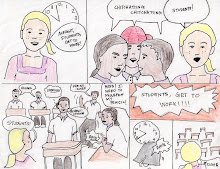This article was about the potentials of “the cloud”, the Internet, as a means of time and cost cutting. There are many free online applications available now that could potentially make software applications an unnecessary expense for schools. For example, there is the Google docs online word processing program, which would eliminate a need for the purchase of such programs as Microsoft Word. The advantages also include less storage space on the computer (so the computer can be smaller and run faster), accessibility of documents from any computer without transporting files, and ease of collaboration. With web-based software, any person, on any internet-enabled computer can contribute to the piece. Schools could save money going as basic as “Netbooks” for computers. This makes the possibility of one-to-one laptop programs seem much more feasible. The cloud accommodates e-mail; web searching and bookmarking; word processing (which is compatible with Microsoft Office and Open Office), presentations (to a degree), and spreadsheets; photo storage and editing; webpage editing; and school-specific tasks such as grade books, reporting systems, communications and accounting. Some problems to consider: accessibility/speed of the Internet; whether these web-based applications will remain free; security of files; privacy of files; and lack of CD or DVD capabilities or big computing tasks (like video editing).
1. Is the one-to-one laptop dream really an affordable possibility? At this point, in the State of California, I would not imagine that this is feasible. Districts are making unprecedented cutbacks, and I believe, for many households, it would be too much to ask parents to purchase Netbooks for their children. Without some kind of subsidy program for the disadvantaged, this would not be feasible, and at this time, I do not see how the government, state or local, could take on such a financial responsibility.
2. If the funds were available, would the advantages of cloud computing outweigh the possible disadvantages? I believe that the convenience of opening work on any computer at any location, as well as collaborating on the work remotely, outweigh potential setbacks in security and privacy. The truth is, any system or computer may lose files or expose vulnerable personal information.








